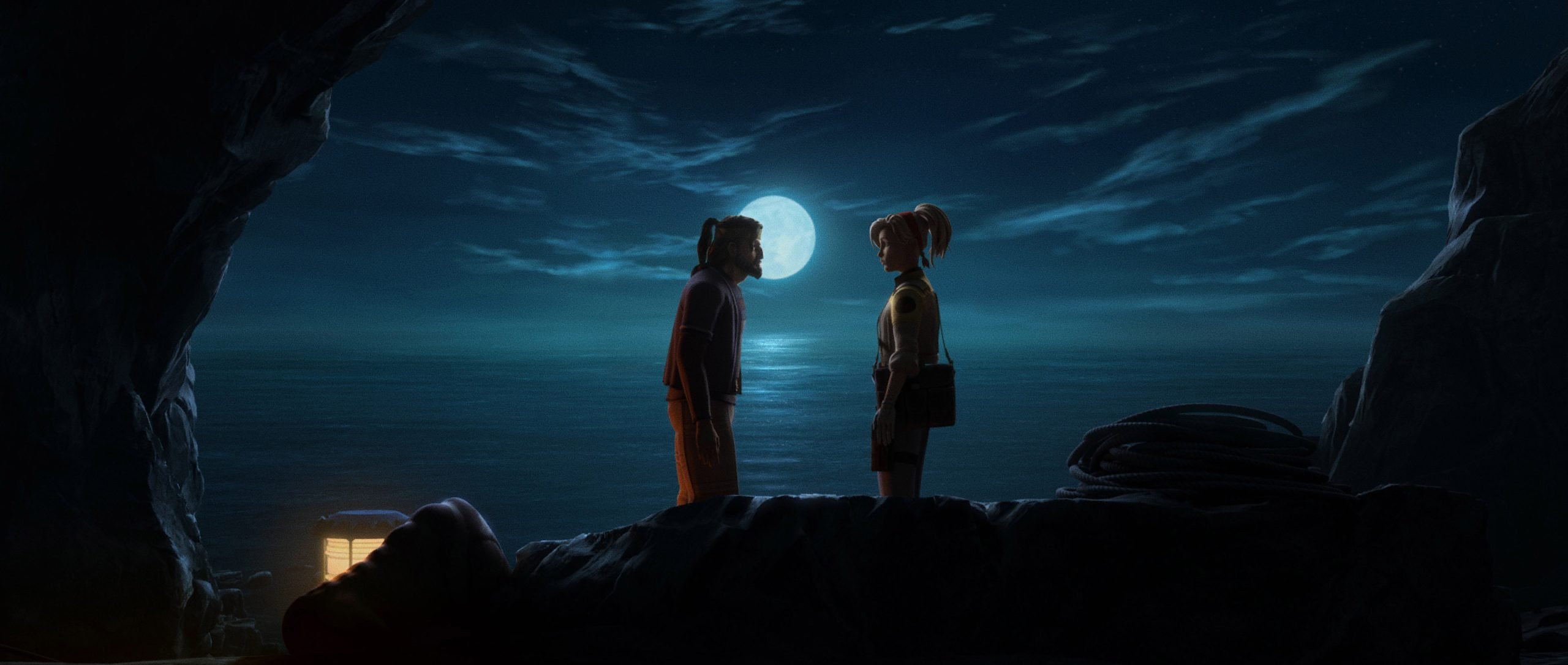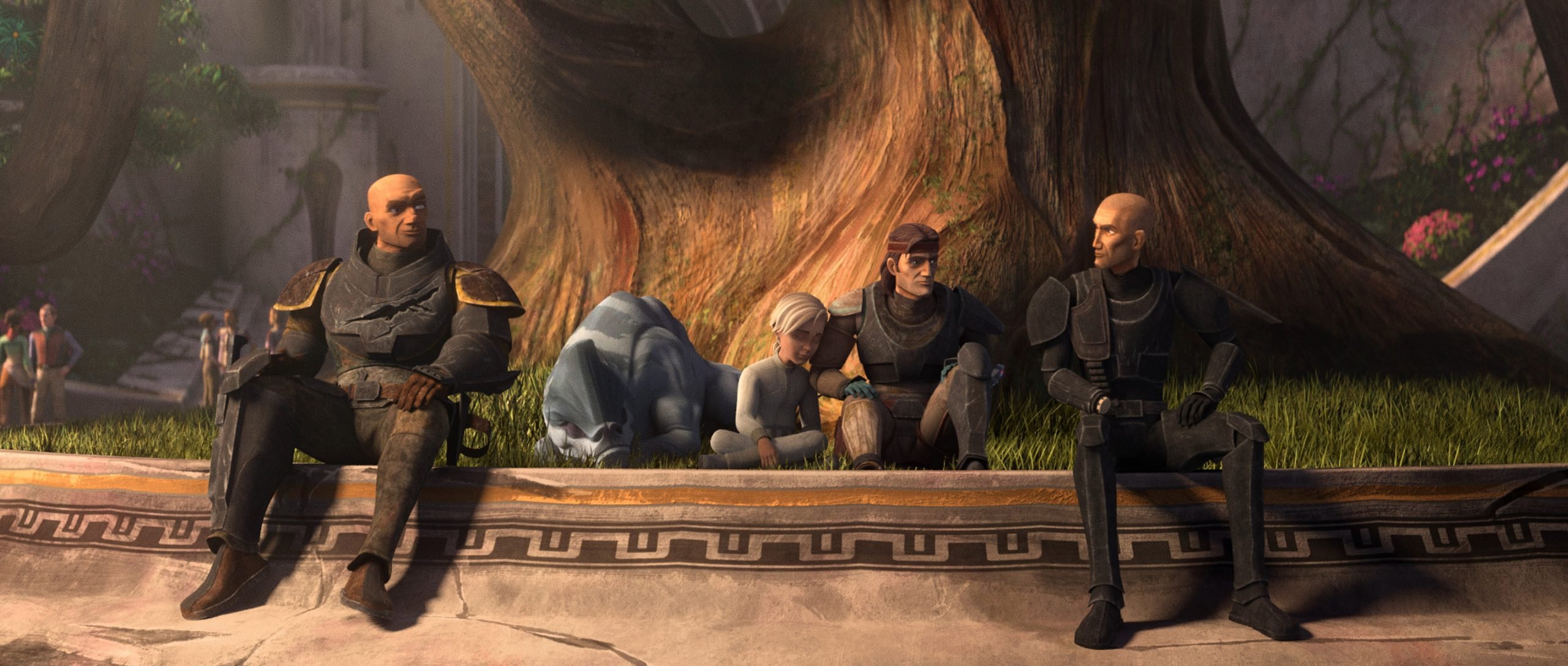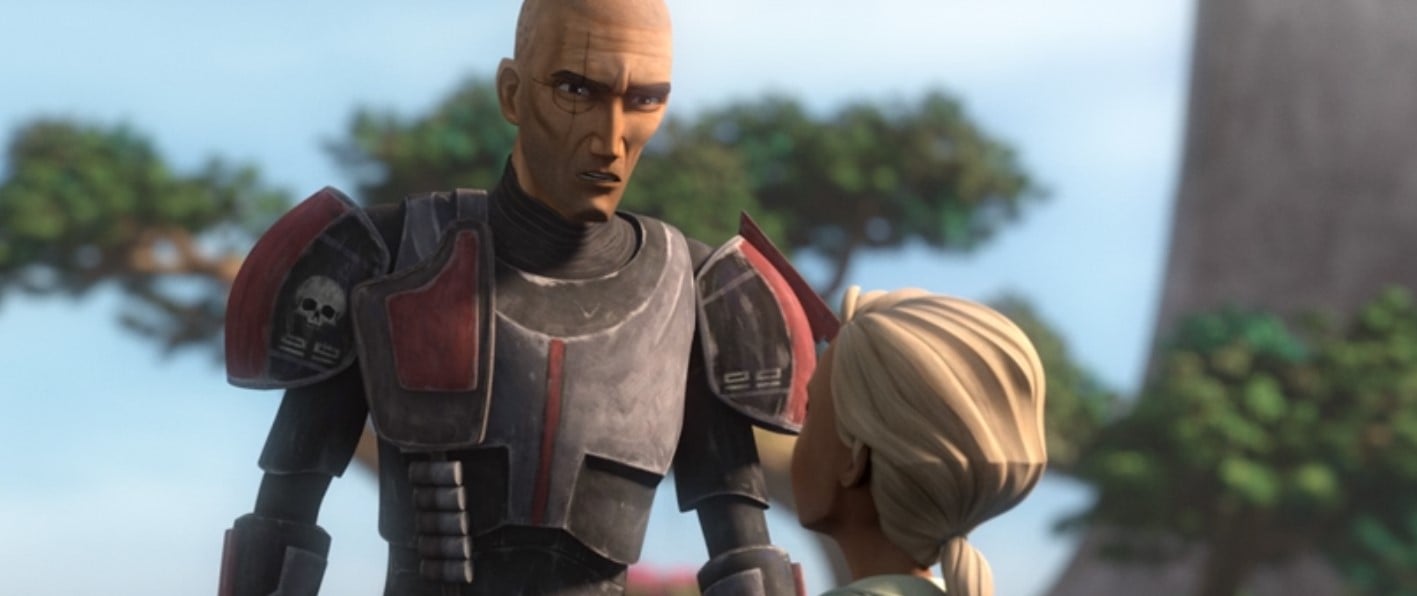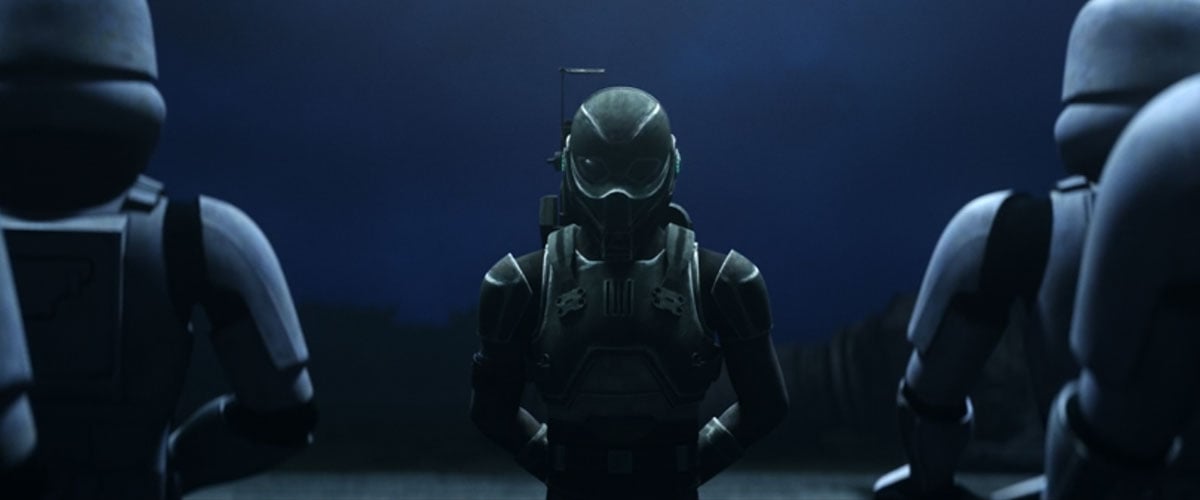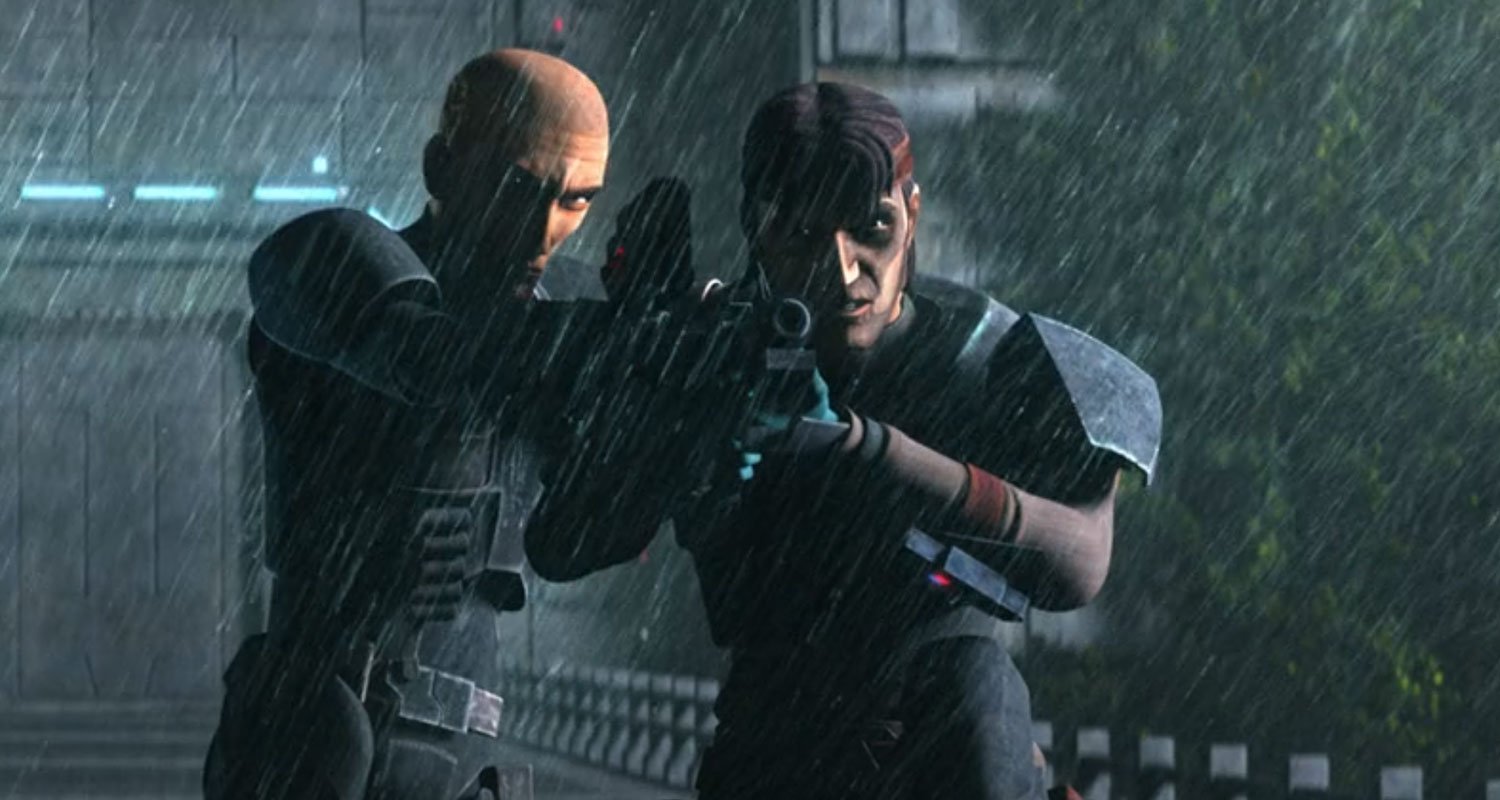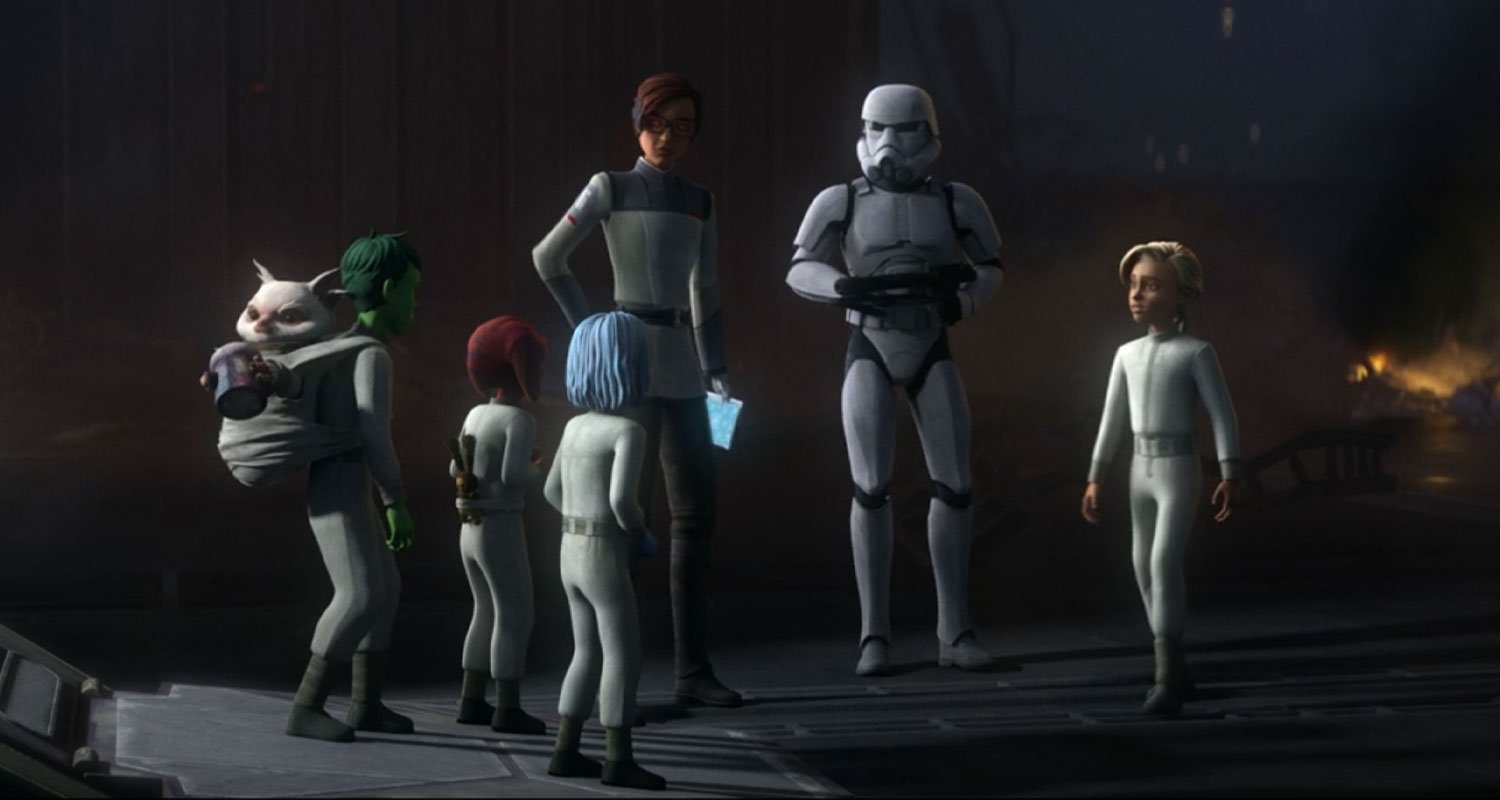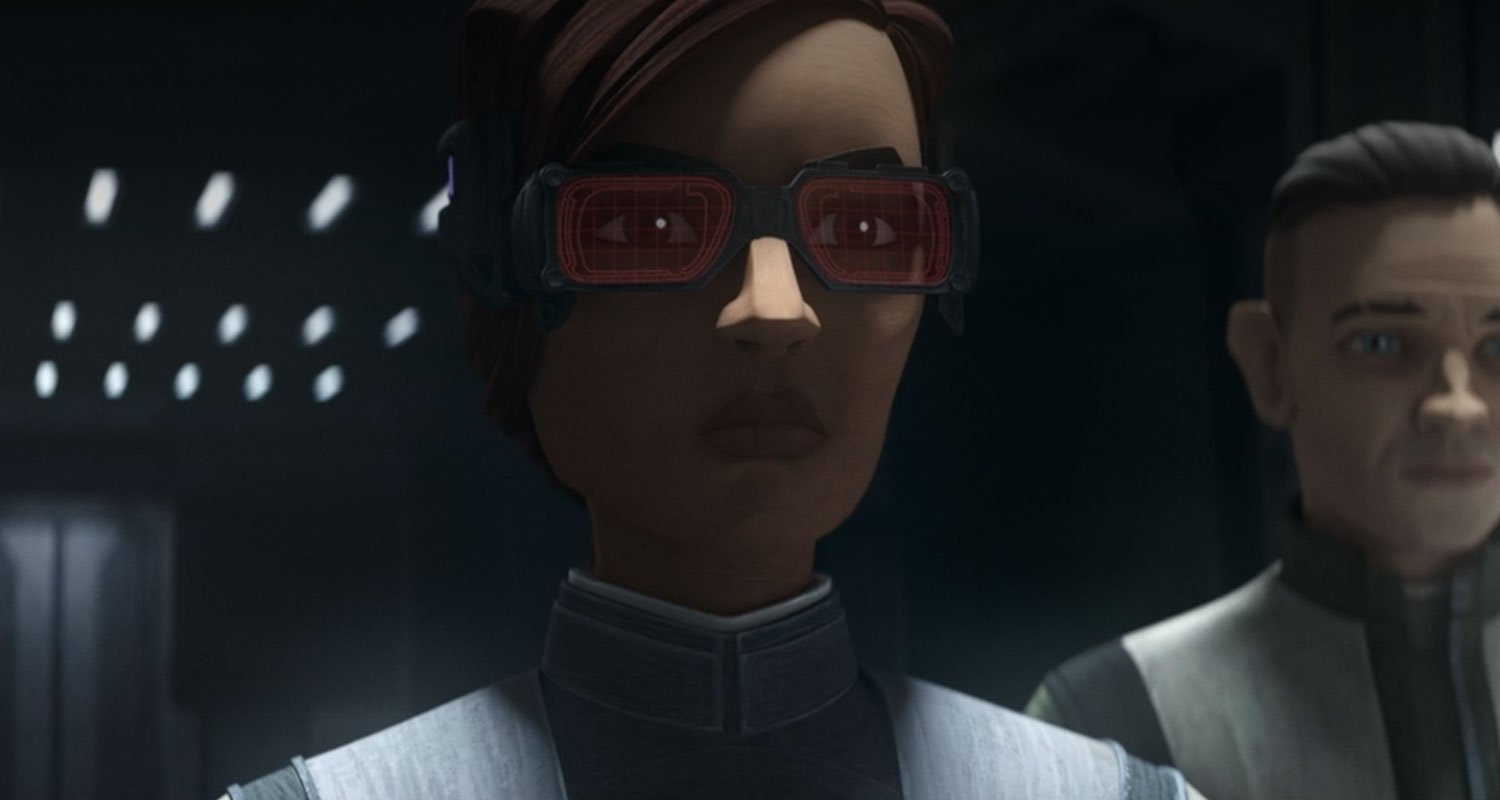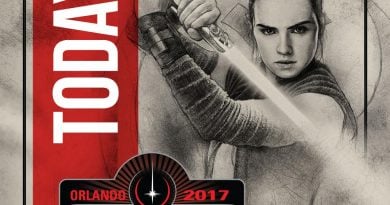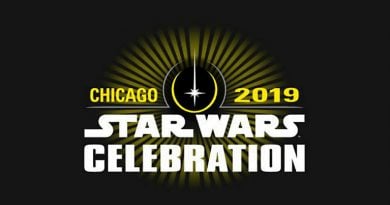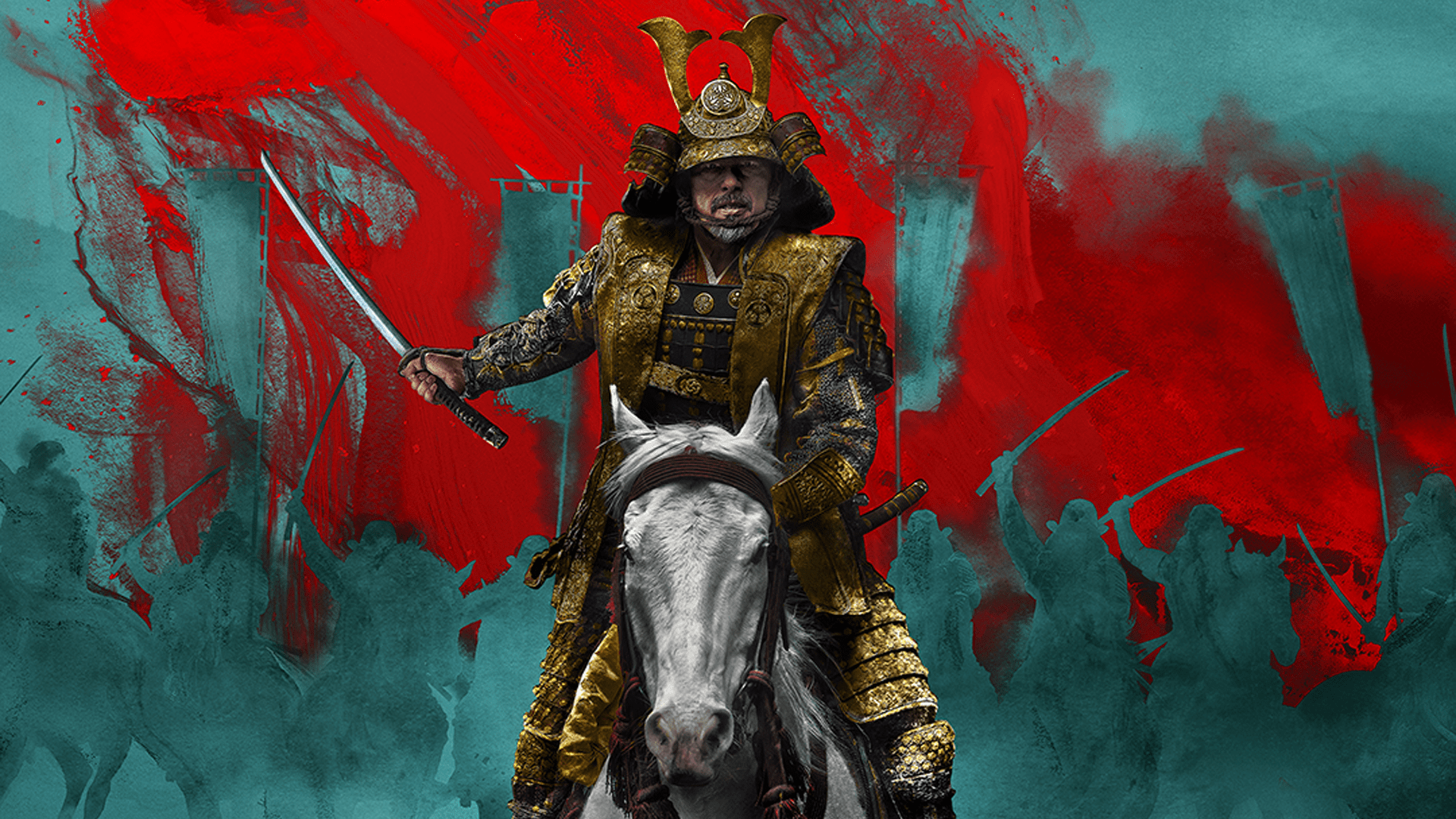‘The Bad Batch’ Cast and Crew Look Back on Series Finale
With The Bad Batch series finale in the rear view mirror, actors Dee Bradley Baker and Michelle Ang, and creators Jennifer Corbett and Brad Rau sat down to discuss the finale and the series in general in spoilerific fashion. Turn away now if you haven’t watched the finale.
Major spoiler warning for The Bad Batch series finale.
Dee Bradley Baker talked about his experience working with so many other talented actors on the show, particularly Michelle Ang.
It’s really been wonderful watching Michelle bring Omega to life. Ultimately, Omega powers this story. She is the moral compass, the center, and the push that moves the story forward and even navigates it. And [Michelle] has done such a beautiful job with it.
It’s a really unique experience to be involved with a show that’s fun, it’s an adventure, but it’s also about things that are important and things that resonate with people deeply. It’s a great, interesting story with really interesting characters.
Sometimes with a team or a group of friends or even with family, things have to be worked out. Ultimately, you end up still together and still on the same mission, but you’ve learned something along the way.
Michelle Ang agreed with her co-star, feeling that that the show was at its best when these different personalities clashed with each other, and that even though they’re all different, Omega never doubted that her brothers were coming for her.
That’s what I really love about Hunter and Crosshair. Just watching these two opposing personalities have to sort of face each other, find commonality, and put aside some of their preconceptions. It’s really cool that these two characters are able, in Season 3, to address the fact that that they have differing viewpoints and that they both have felt wronged by the other in some circumstances, but then they’re able to build on that and move past it for their greater sort of connection and family. And what I love about Omega is how she facilitates that.
I feel very lucky. Not only to have a talented co-star, but also I feel like casting got it right. Dee and I both share the idea of morality being important to each of our individual characters, to the series, and also to us as humans. That is really kind of the heart of both the series and of us as people.
I think a key Omega trait is her certainty. She just knows. And I think that’s the special bond that she has with Clone Force 99. They don’t leave anyone behind.
Some fans may have been surprised to learn that none of our heroes died in the final episode. Showrunner Jennifer Corbett was asked about the possibility of Batcher biting the dust.
I’m sure we talked about it, but I think we wanted the ending to be a bit more hopeful and it didn’t feel right for the story to have one of ’em sort of fall behind. Losing Tech was hard, but we talked about that so much because it is the Dark Times. The Empire is increasing in power and each time they keep going up against them, something bad is bound to happen and they’ve experienced that. But luckily, they made it through this time.
She did mention that Crosshair is a changed man compared to the beginning of season 1, and the need to have him reckon with his past this season.
We put him through the ringer since Season 1, and I think in Season 2 it’s a lot more of self-reflection and coming to terms with what he’s been a part of and watching that evolution in him, where he’s willing to make that change and admit that he was wrong.
But we didn’t want, in Season 3, even though he comes back into the crew, for everything to be happily-ever-after for him because he does still have to address the things that he’s done, both mentally and physically.
And Dee [Bradley Baker, voice of the original Bad Batch members] does such a great job with showing the different shades of Crosshair, because I feel like you can understand where he’s coming from, but also feel like he’s trying in his own way to sort of be a better person. But it always comes down to who’s pushing him to be better, and it’s Omega and the rest of his squad.
Producer Brad Rau then mentioned what a great pairing he and Omega proved to be in the first half of this season.
And Omega, oh my gosh. I mean, speaking of Dee and Michelle [Ang, voice of Omega], what a dynamic duo. They’re so great. We had so much fun with Crosshair and Omega together in Season 3, and as the season went along, we just wanted more of that duo. There’s an episode when we go back to the outpost with the ice worm, where there’s these great interactions where Crosshair is butting heads with Hunter and it’s Omega [telling him], “I told you to talk to him, not to argue!” And just the way that he reacts to her and he listens to her was so beautiful.
Corbett added that this was the first time the pair really got to properly talk to each other all series, as Crosshair’s chip was affecting his brain early on in the series. The pairing really helped him emotionally after experiencing some serious trauma in season 2.
Well, even in the pilot, because Crosshair is immediately affected by the [inhibitor] chip, his interactions with Omega are still so stilted because he’s dealing with that. So even in the pilot when they’re stuck in that cell and she’s trying to get through to him, but she knows that he can’t help it, because she knows about the chip and she knows that that’s really not who he is.
I don’t think I knew the extent of how great Dee and Michelle would perform their interactions in Season 3. They’re just fantastic. But it was better than I thought it would be because Crosshair doesn’t interact with the Batch at all in Season 2. So to then get him together with Omega and the rest of the crew, it’s fun to explore what this new dynamic is, especially, since Season 1, he didn’t refer to her by name at all. It was always like, “the kid,” and he didn’t really want anything to do with her. And what do you do when you pair someone up, who is gloom and doom and sour, with this person who’s just optimism and hope and strength? And they just really took over. I’m glad for that, because Omega had time to be with the other characters. It really felt like Crosshair needed her the most, and that’s what she’s doing in Season 3.
Also, Crosshair knows more about what’s going on on Tantiss than anybody else in terms of the CX troopers. The fact that he’s carrying with him the side effects of Hemlock trying to turn him into a CX trooper, he knows how dangerous they are. He knows how brainwashed they are, and I think that’s also another reason why he’s terrified to go back. He fears what will happen to the rest of his squad if they step into that base and face not only the massive amount of stormtroopers that are there, but also the CX troopers.
CX-2 is kind of an alternate version of what Crosshair could have become. The fact that they interact and fight a couple times throughout Season 3, and the dialogue between them is like, “You could have been one of us,” or “You chose the wrong side,” it just shows that if Crosshair wasn’t technically defective and he accepted the conditioning of Hemlock, that this could have been an alternate version of him. And the CXs are just, I think, so creepy and a cautionary tale. It’s very sad because they are just manipulated clones. But again, it goes to show how the Empire views clone troopers and just troopers in general, which is, they are property that they can use and manipulate in order to complete any mission that they want.
Corbett and Rau also spoke about how Crosshair’s PTSD manifests in the tremor in his hand, and how well it worked as a vehicle to show just what he was going through.
JC: Well, being a sniper, I think it’s very true to a character that that’s his job — where he’s usually more isolated from the crew. That is where he is, he’s always in a sniper’s nest and Crosshair is more of a character that will internalize things. So to have him be a prisoner on Tantiss, and he’s going through this PTSD of the experimentation that he’s subjected to, but he’s also holding in all of this emotional turmoil. Between those two things, it manifests in this tremor. And we show him having to work through it and address it, because even Hunter and Omega were like, “You can’t keep ignoring it. It’s not going to make anything better.” But it did feel like going through something so traumatic, he would have some kind of physical manifestation of that issue.
BR: And it was a really great visual cue. You’ll see through Season 3 a lot of closeups of his hand, and he’s balling his fist so that, like you’re saying, Jen, other characters can see that. It’s so internal, obviously there’s not a narration. It’s a challenge on the visual side — how do we tell the audience what this guy’s thinking without telling the audience what this guy’s thinking? And so it just became a really great visual cue. Honestly, we had even more — we had to pull back. It wasn’t a matter of peppering it in like you’re asking Dan, but really we kept going to that because it was such a great visual cue to show what he was thinking, that we had to pull back in a few places so it wasn’t overkill.
They also mentioned that part of Omega’s arc this season was leading the M-Count children and becoming the “Hunter” of their little group.
BR: We talked about it, for sure. The thing that we really wanted to do, and maybe this segues into a bigger discussion, is we always knew — and we talked about it with Dee and Michelle a lot, too — that once Omega is taken back there, as tragic as that is in the back of your head, we did, like you’re saying, Jen, want the audience to feel like, “Come on, Omega, get in there. You’ve got to help these kids out.” So that once she’s in that role, she’s now the “Hunter” of this group. She became Hunter-Omega. We’ve seen versions of her imitating her brothers or showing the skills that she’s learned from her brothers. But here she really becomes, just short of the bandana, Hunter to these kids. And even the way Michelle performed — it’s a terrible situation but she’s very calm, planning things out, keeping the kids calm, and in charge of the group. It was really, really cool.
JC: And it’s a bit of a parallel to the pilot episode where Omega is not at all trained and they go and rescue her, but are confined and have to find a way out, and it’s really the Batch that’s leading the charge on how to figure this out. Whereas now, Omega, when she goes back to Tantiss, doesn’t have time to wallow or worry because once she sees these kids, it’s like, “Oh, this is not about me. I have to look out for these young children and figure a way out of this mess.”
BR: Which was the other thing that we wanted to show. That yes, her brothers show up, but she gets the kids out. She rescued them herself. It’s pretty cool.
JC: But keep in mind, even if she got the kids off the planet, she still wants to free the clones that are in prison there. So that was what we were always juggling with — showing how she has grown and become a capable person and soldier, but also the teamwork of them joining forces in order to complete the full mission, which is freeing all the prisoners.
They then spoke about the final showdown with Dr. Hemlock, giving special praise to Jimmi Simpson’s performance and discussing the trust required between Hunter, Crosshair and Omega to beat him.
BR: And big high-five to Jimmi Simpson. What an incredible tour de force he delivered as Dr. Hemlock. So chilling. I know fans loathe Hemlock in the best way. It’s so good. [Laughs.] It’s so great, really, with all of this action in the finale and rescuing the kids, and there’s a zillo beast, and there’s an entire team of CX troopers against the Bad Batch. There’s so much stuff going on. The thing, Jen, that I know you and I talked about endlessly in all the versions of this episode, is how do we make that final showdown a personal thing aside from all of the crazy big action? The more we talked about that and figured out the set piece of the antenna array that Hemlock was going to escape on, everything started to come into focus. The way we shot it, there were so many versions, and we kept editing and re-editing, re-recording a couple of lines, just trying to get the rhythm just right. It was a tricky thing.
JC: Hemlock, he’s not a commando, so his only option of getting out of this situation is Omega, and he’s at his lowest point because his data’s gone, his secret base is now compromised, and he knows the Emperor is going to be really ticked off. But as long as he has Omega, then he still has his trump card. And again, that showdown would not work if it wasn’t for Hunter and Crosshair trusting Omega to know what to do, and for them to sort of be in sync and for Omega to trust Crosshair to make this very difficult shot, which he’s even nervous about. But again — back to the meditation, centering himself and coming through.
BR: Yeah. And even to that, now he’s not only got a tremor in his trigger hand, he doesn’t even have that hand. So he has to take this shot with some strange rifle that he’s not practicing on with his left hand, leaning on Hunter. Dee did such a great job — you just hear the tremor in his voice when he’s hesitant to take the shot. Hunter trusts him, Omega trusts him. What a wild thing. And he makes it.
They then spoke about the beautiful epilogue that the show ends on, and how their idea of how the series should end kept changing over the years.
JC: I think early in the development of Season 1, the discussion was really, “How does it end and how do we see it ending?” So we had some discussions about, would Clone Force 99 walk away? Are they going to stay in the rebellion? How does it all really come out? And it kept kind of changing as the seasons were progressing.
But as we were in Season 3, we talked a lot about this scene, and I can’t remember when we knew what we wanted to do. We wanted it to be a very personal moment because we wanted to show all the training the Batch has done and for Omega to be older, and now it’s her turn to make a decision in her life as to what path she wants to take. For me, it was personal because I was going off of when I joined the military and how my parents were obviously very concerned about it, but how I kind of felt like I had to go and make my own choices and decisions.
And I think it’s always been telling Omega’s story, but also, I think, one of my favorite moments is when she’s flying off and Batcher’s upset, and Hunter’s like, “Don’t worry. She’ll be fine.” Even though he has his worries, he knows that this is what she’s meant to do and this is what she has trained to be. It’s really just kind of like him letting her be who she wants to be.
BR: Yeah, I mean, having sent two kids to college — that moment, it’s a proud moment, but it’s so bittersweet and you know your life is going to change. So yeah, it’s really interesting, Jen, that you and I had these different points of view on that. And honestly, different members of our team, as we were making it, shared in those different points of view.
It was a very cathartic thing, strangely, for us as creators, but also being able to show that these soldiers could decide to put their guns down in this terrible time is a beautiful thing. But also the question could maybe come up, if they could still help people, why don’t they help people?
And so we hope that with the epilogue we’re showing that they are doing both. They got to have peace. They got to step aside from the battle, put down their guns and stop causing more violence. And yet, how could this kid who’s learned so much from her brothers stay out of the fight forever? She couldn’t. We just really wanted to show that, too.
Dee Bradley Baker and Michelle Ang also said their piece about the epilogue.
The Bad Batch has a spectacular finish, as you would expect from Star Wars, but it has a particularly beautiful and affecting epilogue. It’s really a beautiful moment that plays out.
It was a bit of a relief to jump ahead in time and to see ‘Okay, everyone’s okay. We’re still here. We’re all right. Good.’
What really inevitably has to happen is the child needs to step out into the world her own person and to do what she has to do. If you can call the Bad Batch, you know, the Dad Batch…I think everybody has learned something along the way. The good news is that Omega makes it out and she makes it on her own. Off she goes. Dad’s left back with the dog, and you’ve got the satisfaction of the memories that you’ve forged together and [the knowledge] that she has become her own person. What more could a parent want?
Ang found the epilogue particularly emotional, reflecting on the end of her journey with The Bad Batch.
That epilogue really hit me in the feels. This idea of Omega starting a new chapter that she’s so ready for, that she feels compelled and drawn to, that everything has been leading up to, has resonance for me. This whole experience was so new for me. Working with the Star Wars family, working as a voice actor, doing things remotely, holding space with [Dee] when we get to do Celebrations and conventions. And now, having this character realized and grown up, I feel like my personal journey has mirrored Omega’s in some way.
One of the show’s most interesting subplots was the idea of “what happens to the clones after the war?” Rau and Corbett talked a bit about how that idea formed.
BR: I mean, we’re fans. We’re big fans, so that’s the stuff that we talk about. We’re always looking for ways to ask those questions and address those questions and get them in there. So yeah, anytime we had a chance to do that, we were all in a hundred percent.
JC: Early in the development of the show, the one question I had going in was like, “What happened to the clones?” I’m a fan of The Clone Wars, and all of a sudden, they’re gone. So I felt like it was exciting for us to be able to tackle some of those questions. We always try to ground each of these stories in something real-world, and the early concept was talking about veterans who now no longer have a war to fight. Now it’s these clones and the end of the war, the beginning of the stormtrooper program. Now we have thousands of clones in the galaxy who are going to be out of jobs, and that has been their sole purpose since their creation.
So it was really exciting for us to be able to bring this political issue there. And again, it also shows that there are people in the galaxy, even though the Empire is the rule, who are fighting for the clones and who are trying to still do right by them, like Senator Chuchi. But again, it just felt like a very real-world topic that is very relatable to these clones, and then also to military veterans today.
Corbett then tackled a deep question: what do the clones think of their service in the Republic and then the Empire?
I think it depends on each clone. The Republic is just so different from the Empire, and I think that’s why the sudden change is so jarring, especially for Echo, since he’s technically a reg but didn’t execute Order 66. So he’s now witnessing what his brothers are doing, but he’s not affected by the order.
I think it was episode two when they’re going to visit Cut Lawquane, and Tech describes Cut as a deserter. Echo is like, “You trust a deserter?” and Tech’s like, “Well, why not? We’re deserters too, now.” And you can see Echo’s reaction, which is like, “Oh my God, we are.” He has just always been the straight-A soldier who believed in what they were doing, and now it’s like, “Well, now I’m not a soldier. I’m a deserter. What am I supposed to be doing with the rest of my life? This was all I know.” So again, I think it affects him the most because that’s just who he is.
With the Batch, I think they were the never-fail squad, but then when Omega came into the picture, Hunter, especially, started questioning what else is there for them because he wants to give her a better life than they had. She’s been confined on Kamino and hasn’t had a childhood, and neither have they. So I think it’s always been in the back of his head that they need to think of another option to really not settle down, but just find out what else is out there for them.
Brad Rau and Jennifer Corbett spoke about the M-Count children and the vibe they were trying to create for that setting they were confined to.
BR: We always knew we wanted to evoke a very THX [1138] type of a vibe. And so in designing how big that place was and where the tables were, we talked about it endlessly for a long, long time. When it came to casting those characters, there was a lot of discussion and we really wanted to cast children in the roles to make it as authentic as possible. And wow, huge high-five to Lindsay Perlman, our casting director, to provide us these incredible actors. They did such a good job, and they’re very, very young. Every time I watch those kids — as many times as we’ve seen the episodes and the shots and various versions — it always gets my heart like, “Oh my goodness, these children, we must save them as fast as we can.” The cast did a great job.
JC: I think it was episode one of Season 3, you first hear about the “specimens” in the vault, but you don’t know what it is. And we intentionally didn’t want to show them until we knew Omega was going to be going back there, just playing with the mystery. And once the Emperor shows up, it’s like, okay, so what’s in the vault? So finally when we got to have the episode that was focused on Emerie and we see her reaction to it. It’s very impactful for her because this is not at all what she was expecting — to find these young children stuck in this very sterile and clinical environment. As soon as you see those kids stuck there, we and hopefully the whole audience is like, “Omega needs to get back there and Omega needs to rescue them.”
BR: I will say also that we talked a lot about the fact that they needed to be very young because they may have a high M-count, but they are not trained in the ways of using the Force as we know it. It was very, very, very important to the longstanding history of Star Wars and what we say of how you can use these abilities that you might or might not have. So that came up a lot, and you even see it in episode 10 when young Jax tries to escape. Just to make sure that we were telling that story clearly, that yes, he may have a high M-count, but he does not know how to use it. He doesn’t even make it out of the vault room before the door is shut. He’s helpless. He could do nothing until, like you’re saying, Jen, Omega shows up. And then it’s on.
JC: And we were very careful to not make the episode that you first meet them too scary. Even in the conference when we first talked about this idea, concerns were raised. When you’re talking about children being confined, you just need to be very careful with how you do it. So we just wanted to make it clear that the kids aren’t fully aware of what’s going on and the nanny droids and what they’re doing. You do have a reaction to it, but we were just trying to make it be, I guess, as easy for an audience to take, but it’s supposed to be a little unsettling.
They expanded a little bit on the process behind creating the Balaans card game we see in season 3’s third episode.
BR: The card game came out of several conversations and Andre Kirk, our art director, and one of his designers helped build a real card game with real rules. We play-tested it. It’s pretty fun. It’s actually really cool. It’s kind of like a combination of Uno and Magic the Gathering. What a great thing, when we started going down that road. We shot almost an entire game between Omega and the Trandoshan, and then later between Omega and Officer Mann. And we just nerded out way too much, and it was way too much footage. We loved it, but we had to cut it down to what you see in the episode. But yeah, we had a lot of fun with that game.
JC: I think there were two times in Season 3 where we had so much footage, and one was the card game and the other one was Crosshair and Omega meditating. [Laughs.] We were like, “This could be a whole episode. Just these two, the card game and the meditation!”
Brad Rau and Jennifer Corbett were asked a little about the world building they did for the Empire through the eyes of Emerie Karr on Mount Tantiss, even the inner workings behind the walls that Omega ended up crawling through.
BR: Emerie is a great example of telling the story of a very specific role in the Empire from a very specific point of view, with a very important character and her really slow arc through the show. But we also got an opportunity to design and build out all of this fun technical stuff. Some it very specific, some of it intentionally not specific. [Laughs.] We have so much fun visually building out the world, as well. Tantiss, there are so many nooks and crannies that we kept going further into and having fun expanding on. But that’s just a very specific part of it.
JC: And because we’re still in the early years of the Empire, we knew we weren’t going to be able to do something huge, like talk about the Death Star or deal with the Empire in that regard. But our show has always really just been about the clones and the clone troopers and their purpose now that the Republic has gone and things have changed. We wanted the Empire’s point of view and the villain to really be connected to the clones. And we see that in Season 1 with Tipoca City and then also with the cloning that’s going on on Tantiss for the Emperor. It’s really just more of how the Empire’s affecting the clones and keeping it contained in that way, so it feels like a satisfying story for the show.
Jennifer Corbett cast her mind back to the beginning, when they were planning out the idea for what The Bad Batch might be, and how Omega the character came to be.
It came up in the development of The Bad Batch. I had watched the animatic, which was being worked on for the final season of The Clone Wars, when we started developing this series and was talking about the timeline and where Clone Force 99 would be during Order 66, and what kind of stories we wanted to tell with them.
Then the discussion led to Omega and the possibility of there being this young clone girl on Kamino, who is a misfit or an outcast similar to the Bad Batch, and then how that would affect their team dynamic now that not only is the war over, the Empire’s now in power and they don’t want to be a part of it, but now there’s this kid that they can’t just leave behind because she’s considered a defective clone like them.
That’s how it really started, but I think it was such an exciting decision because when you watch them in The Clone Wars, they’re kind of like the guest stars of the mission. Anakin’s on the scene, they’re doing all this really cool stuff to save Echo, but when you give them their own show, especially in this timeline, it’s like, “Well, what are they doing? And how are you going to really challenge this never-fail-squad and see different parts of them?” It felt like introducing Omega was a challenge — the fact that, oh, now they have to be guardians. And that’s very different than being a super-elite commando.
Finally, Rau and Corbett answered whether or not they think we’ll see the Bad Batch again.
JC: I dunno. I think there’s always room for more stories in various versions. We’re just so attached to them. They’re our family so it’s hard to say goodbye, but I’m very proud of what the team has done.
BR: Yeah, agreed. I mean, we love these characters so much. It’s been so fun working on the show. I feel like, in all of the millions of discussions, Jen, that you and I have had on the show, that we are really happy with how we did end this chapter. Knowing when we went into the season that this would be the final season as we’d always planned, it was really satisfying to tell the story the way we wanted, the way we wanted to end this chapter with these characters.
For the full interview with Jennifer Corbett and Brad Rau, head to StarWars.com, where you can also find the full interview with Dee Bradley Baker and Michelle Ang.
Josh is a huge Star Wars fan, who has spent far too much time wondering if any Star Wars character could defeat Thanos with all the Infinity Stones.

